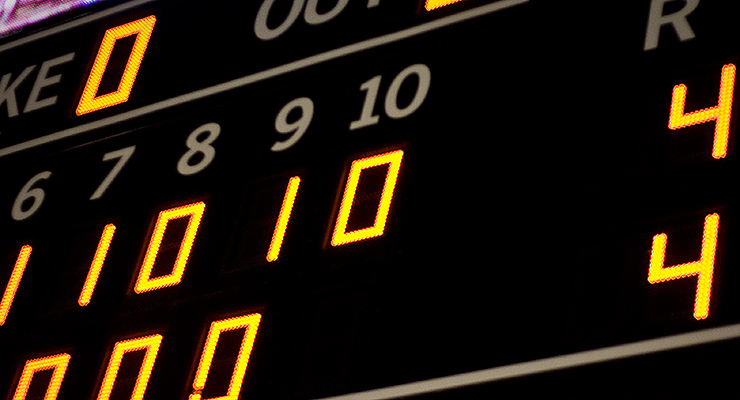Baseball is one of the only sports to have a predetermined setting or rule to dictate which team starts the game.
So who bats first in baseball?
The visiting team (also known as the away team) bats first. The home team bats second, or in the bottom half of each inning.
A baseball game is played by innings without a time limit (some levels have time limits for a total game time, but at very young levels). Each inning is split into two halves. The visiting team bats first; in the top half of each inning, and the home team bats second; in the bottom half of each inning.
The visiting team always bats first in baseball. To a newcomer, it may seem like batting first is an advantage. However, this unique rule or setting in baseball makes it possible for the home team to always have a chance to still win the game, being that the home team would always have the last at-bat. Last-at-bats can result in exciting “walk-off” wins and give them a home field advantage.
Contents
- Leadoff Hitter
- Will the home team in baseball always bat last?
- Why does the home team bat last?
- What is a walk off?
- Who is the player that bats first in baseball?
- Does the best player bat first?
- Does the worst player bat last?
- Where should the best player bat in a batting order?
- Who Bats First in Baseball Conclusion
Leadoff Hitter
The first hitter for the hitting team is known as the leadoff hitter. The leadoff hitter is typically one of the faster players on the team that sets the table for the rest of the team. Leadoff hitters typically are middle infielders or outfielders.
Here are some of the top leadoff hitters in MLB history:
Will the home team in baseball always bat last?
Technically, no. In baseball, the home team would only bat last if the game is tied or the home team is losing.
For example, in Major League Baseball a game is 9 innings. If the visiting team is losing in the top half of the 9th inning (which is the last inning), and they do not score enough runs to tie or take the lead in the game, then the home team wins.
The home team would have no reason to take their last at-bats in the bottom half of the 9th inning because they have already won the game. The visiting team has run out of at bats or innings to keep the game from ending.
Why does the home team bat last?
The rule in baseball to have the visiting team bat first and the home team bat last is to give the home team the final chance to win the game.
In the early stages of baseball, this rule was made because it was hypothesized that the home team would win a greater percentage of games if they batted last. If the home team is winning more games, it’s a better situation for the home crowd and home city in general.
Like many sports, teams want the ball last. It is very common in basketball and football to see a team want the ball last in a tie game or when losing the game. This is because that team still has hope and is in control of their destiny. If you don’t have the ball, you don’t have the chance to score and win the game.
The same type of scenario is played in baseball, except the baseball team technically doesn’t have the ball last, they have the bat last. The last at bats means the home team has the last chance to win the game.

What is a walk off?
Part of the beauty of baseball is not having a time limit. Because of this, if the game is tied or the home team is losing going into the last inning of a baseball game, the home team still has a chance to win. This is because they have the games last at bats. In the last inning of a baseball game, if the home team scores enough runs to take the lead, they win the game and this is known as a “walk off” win.
The term “walk off” comes from players literally being able to just walk off the field because the game is over. There is no need for any more pitching or defense at that point by the home team because the game is over, and the home team has won.
Only the home team in a baseball game can get a “walk off” win. For more information about baseball not having a time limit, see our article “Does Baseball Have Overtime?”
Who is the player that bats first in baseball?
The baseball player that bats first for each team in baseball is known as the “leadoff hitter”. This term is derived from being at the top of the team batting lineup, thus “leading” the lineup of hitters.
Typically, a team will use a hitter that can run fast and make consistent contact with the bat and baseball in most baseball games. Having this type of hitter as a teams leadoff hitter has been the conventional way of creating a lineup for decades in baseball. Why?
The main reason you would choose to have a leadoff batter be someone who has speed and puts the baseball in play is due to multiple reasons. The first reason is that the player statistically has the best odds of reaching base due to contact and speed. By reaching base, that fast hitter now becomes a fast base runner, which helps the next batter in the lineup increase their odds of bringing that runner in to score.
Another reason you would choose this type of hitter as the leadoff batter is because the leadoff batter has the best chance at batting the most times in a game. Strategically, you would opt to have one of your best and fastest hitters not only bat first, but also bat the most times in a game.
Does the best player bat first?
This is a tricky question in baseball because the best player doesn’t necessarily have to be a team’s best hitter. A player can have immense value as a pitcher or defensive player as well and help a team win in more ways than just batting. A team’s best player doesn’t always bat first. Many teams put a player that has a high on-base percentage first because the goal is to get runners on base early and drive the run in.
In baseball, a team’s best hitter could be determined by just looking at the hitter’s statistics. But it also comes down to what a manager, coach, or team considers to be “best”. A player might have a high batting average and thus gets on base a lot, but maybe that same player doesn’t hit extra base hits, homeruns, or come up clutch.
By the same account, a player with a lower batting average might hit for a lot of power. That hitters’ statistics might reflect a lower batting average, but other statistics stick out. Common ones include: homeruns, rbi, walks, and batting average with runners in scoring position. Having good statistics in these categories have more value in helping a team win.
Does the worst player bat last?
Baseball batting orders are unique in that they are more of a baseball managers personal preference on how they set a lineup. As stated, a team’s best player doesn’t always bat first, and a team’s worst player or worst hitter doesn’t always bat last. It’s all a matter of strategy.
In Major League Baseball, the National League has a rule that the pitcher must bat, whereas the American League has a designated hitter. A designated hitter is almost always used in place of the pitcher batting because the pitcher is usually a team’s worst hitter.
In the National League though, you will almost always see the pitcher batting last, or 9th in the batting order.
In lower levels of baseball, it is very common to see a team’s worst player or hitter be used last in the batting order. Like having a good hitter bat first to increase the odds of that hitter batting more times in a game, you may choose to have the worst hitter bat last to decrease the odds of having that hitter bat more times in a game.
Where should the best player bat in a batting order?
Strategically, the best player or hitter should bat in the top 4 spots of the team’s batting order. Having your best hitter occupy a spot in the lineup in one of the top 4 spots is very common in baseball. An example of this was mentioned previously with choosing a leadoff hitter.
You may opt for the best hitters batting early in the lineup to increase your odds of having those batters hit more times in a game. Another reason is for a strategic move to increase their odds of scoring runs by having the best hitter bat after another good hitter, and to increase their odds of scoring earlier in a game.
Who Bats First in Baseball Conclusion
As stated, the visiting team, also known as the away team, always bats first in baseball games and the home team bats last in baseball.
Baseball is played by innings, with a top half of an inning and a bottom half of an inning. Higher levels of baseball have 9 inning games, mid-level baseball has 7 inning games, and lower-level baseball has 6 inning games.
There is no limit to the number of innings played, but the home team bats last baseball to give them the last opportunity to win the game. Because of this, the visiting team will always bat first in baseball.
Other Popular Articles:
Does Baseball Have Overtime?

